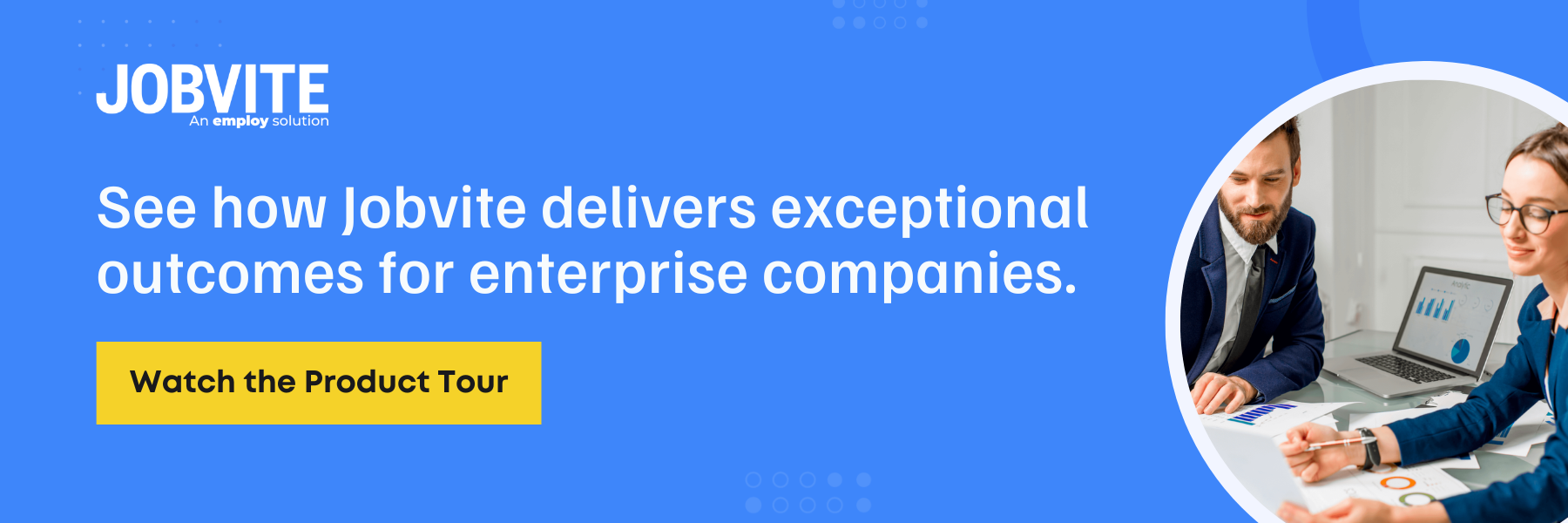As a talent acquisition professional navigating the uncertainty of today’s job market, it’s crucial to prioritize two areas of recruiting that are always in season: quality and speed. But how can you achieve these goals, while dealing with unsteady market conditions and increased competition for top talent?
Jobvite’s latest guide, The Enterprise Guide to Talent Acquisition, can help you and your team learn how to tackle the biggest challenges your organization faces, improve overall candidate quality, and drive hiring efficiencies across your recruiting function. This comprehensive guide examines three key strategies for improving recruiting outcomes in enterprise organizations:
- Pursuing Scalability as a Strategic Advantage
- Focusing on Technology and Process Prioritization
- Consistently Improving Recruiting Outcomes

The Enterprise Guide to Talent Acquisition examines these three areas in depth and highlights how other talent acquisition leaders and professionals use purpose-built recruiting strategies and technologies to improve their recruiting outcomes. Here’s a sneak peek of what’s inside:
Pursuing Scalability as a Strategic Advantage
The ability to scale hiring up or down is crucial for navigating rough hiring terrain, no matter the size or complexity of the organization. But for enterprise companies, a scalable recruiting strategy allows hiring teams to analyze and optimize their recruiting processes, evaluate and improve on key recruiting metrics, shorten the hiring process to fill roles quicker with qualified talent, and easily adjust to changes in the job market to meet candidates where they are.
Scalability is necessary to remain competitive in winning over top talent. While growth brings its own challenges, it’s essential to focus on how you can scale hiring as a strategic advantage. Recruiters and talent acquisition teams should leverage the following advice to take action and improve the versatility of their recruiting function:
#1: Review Current Recruiting Processes
Talent teams seeking enhanced scalability should start by analyzing and optimizing their current recruiting processes. This includes identifying gaps, streamlining workflows, and leveraging technology to improve efficiency.
In an enterprise with complex workflows, hiring in multiple geographies or locations, or looking to fill a high volume of positions, speed is critical. It’s vital to ensure that no time is wasted on tedious tasks garnering minimal results or disparate hiring efforts that lead to greater inefficiencies.
Organizations should ensure they are using recruiting tools that seamlessly integrate multiple parts of the talent acquisition lifecycle. For example, make sure the applicant tracking system works in lock-step with a candidate relationship management (CRM) system to build a robust talent pipeline that nurtures and grows relationships with candidates.
#2: Measure Key Recruiting Metrics
To effectively scale recruiting, hiring teams must also identify and track key metrics to understand where they are performing well and where they can improve. Below are examples of metrics that are essential to measure the success of the talent acquisition function.
Cost per Hire is the total expense incurred to fill a job opening. It includes advertising costs, recruiting fees, travel expenses, time required for sourcing, screening, interviewing, and onboarding, and any other associated costs. Tracking this metric is essential as it allows companies to measure the cost-effectiveness of their recruitment strategies and identify what is working and what is not. By focusing on keeping recruiting costs down, hiring teams can save money and invest those resources elsewhere, maximizing their budget for recruitment and retention efforts.
Time to Fill is the length of time it takes for a job opening to be filled, from posting the job and interviewing to hiring an applicant. Tracking this metric is crucial because a longer time to fill can lead to lost productivity, increased costs, and even potential business disruption. When jobs remain unfilled for prolonged periods, workloads tend to pile up, creating bottlenecks that impede the company’s growth. A shorter time to fill allows recruiters to move quickly, attracting top talent before they take other job offers.
Quality of Hire measures the impact or value a new hire brings to an organization. Focusing on the quality of hire is a priority for many organizations, with 61% of HR decision makers and recruiters saying it is their top priority in recruiting.
Yet, quality of hire can be one of the most difficult metrics to measure. Common ways to measure it can include pre-hire candidate assessments, hiring manager satisfaction, new hire attrition, job performance, turnover rates, time to productivity, employee engagement, and cultural fit.
Candidate Experience is the overall impression that candidates have of an organization’s recruitment process. It pertains to the level of satisfaction or dissatisfaction that candidates feel throughout the hiring process, and it is crucial to track because it impacts the company’s reputation.
Candidates with a positive experience are more likely to advocate for the company to their professional network, friends, and family. On the other hand, poor candidate experience can lead to negative online reviews, damaged company reputation, and difficulties retaining current employees.
Download the Complete Guide
Ready to get moving? The Enterprise Guide to Talent Acquisition provides even more insights and strategies for recruiting success. It’s a must-read for talent acquisition leaders looking to stay ahead of the competition and improve their overall quality of hires.
Download the guide today to start improving your recruiting outcomes. With Jobvite’s guidance, you can optimize your recruiting strategy and attract the top talent you need to succeed.
And if you’re ready to take the next step, then take time to see Jobvite in action by watching this product tour.





